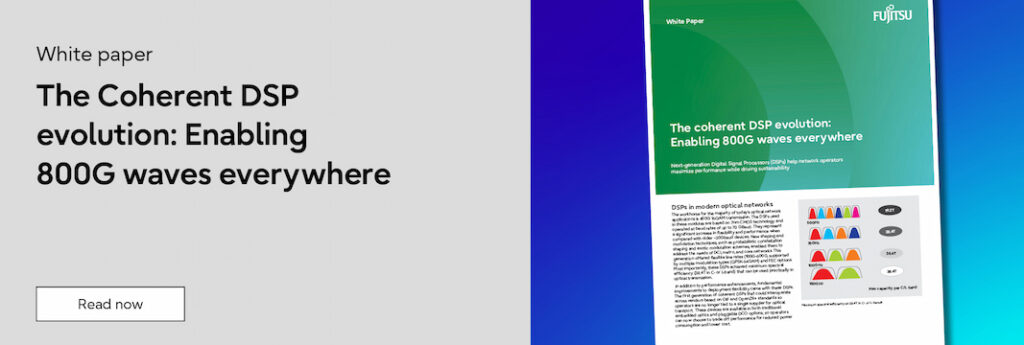
Thanks to Moore’s Law – an empirical law dating from 1965 which states that the number of transistors in an integrated circuit doubles every two years – the latest generation of digital signal processors (DSP) for optical transport networks has received a significant performance boost. This increased processing power boosts optical performance in all key domains: bandwidth, noise tolerance, compensation for fiber-induced dispersion and non-linear distortion, reach, data collection and machine learning, and energy consumption per bit. In this blog and related white paper, we explore how the latest evolution of coherent DSP technology promises to reshape optical transport networks.

The figure above highlights some key technological advances. Let’s take a deeper dive into a few specific areas.
5nm FinFET CMOS
Compared to the previous generation optical DSPs which used a 7nm fabrication process, the latest generation packs far more field effect transistors (FET) per chip. Each FinFET transistor is a three-dimensional structure, compared to the planar MOSFET transistors of earlier generations.
Smaller transistors mean less energy is required for electrical switching, which reduces power consumption per bit. However, the higher transistor density means that the chip generates more heat overall – thus the addition of a liquid cooling system (instead of standard air cooling) to maximize heat dissipation.
Coherent driver modulator
Coherent optics leverage QAM (quadrature amplitude modulation) instead of simple OOK (on-off keying) to modulate both the phase and the amplitude of a signal for transmission over fiber. Higher order QAM delivers more bits per symbol: 64QAM is 6 bits per symbol, compared to 4 bits per symbol for 16QAM. The symbol rate is denoted in baud.
The bandwidth is calculated simply by multiplying the baud rate by the number of QAM bits. To increase the bandwidth, either the baud rate has to increase, or a higher order QAM must be used. The latest 135 Gigabaud (GBaud) DSP does both. The baud rate is double that of the previous generation 70 GBaud DSPs. More sophisticated QAM constellation shaping techniques have also been developed to maximize tolerance to noise and hence lower the SNR thresholds required to achieve higher order QAM.
For long-haul applications, optical reach can be maximized by using a low order modulation with a high baud rate. For short distance data center interconnect (DCI) applications, bandwidth and spectral efficiency can be maximized by using a high order modulation with a low baud rate. When combined with a forward Raman amplifier, an 800G wavelength can be transmitted up to 1800 km without requiring electrical regeneration.
Liquid cooling
The CPU of a typical desktop computer is cooled by a fan. For high-performance computing or gaming, air cooling is insufficient for the amount of heat generated and a liquid cooling system is needed. Coherent DSPs have now reached that point. The closed-loop liquid cooling system used in the 1FINITY™ Ultra Optical System is adapted from Fujitsu’s Fugaku supercomputer.
800G everywhere and 1.2T in the metro
400G wavelengths represent the majority of today’s optical transport applications. The introduction of the latest coherent DSPs will double the industry standard to 800G. This evolution is expected to be a graceful transition for network optical channel planning. A doubling of the baud rate doubles the channel size, which means fixed grid networks can maintain their channel plan and avoid unnecessary spectral fragmentation. For DCI applications and point-to-point links up to 300km, 1.2T wavelengths can be achieved.
For a deeper dive into how the latest coherent DSP technology will enable 800G waves everywhere, read our whitepaper.
